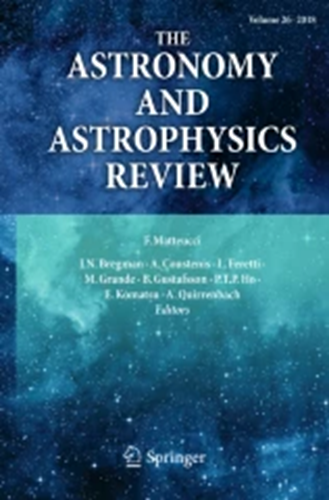The peculiar nebula Simeis 57
IF 26.5
1区 物理与天体物理
Q1 ASTRONOMY & ASTROPHYSICS
引用次数: 0
Abstract
Simeis 57 (HS 191) is an optically bright nebula in the Cygnus X region with a peculiar appearance that suggests an outflow from a rotating source. Newly obtained observations and archival data reveal Simeis 57 as a low-density ($n_{e}\,\sim\,100$ cm$^{-3}$) nebula with an east-to-west excitation gradient. The extinction of the nebula is $A_{V}\,\leq$ 2 mag. The nebula is recognizable but not prominent in mid- and far-infrared images. In its direction, half a dozen small CO clouds have been identified at $V_{LSR}$ = + 5 km s$^{-1}$. One of these coincides with both the optical nebula and a second CO cloud at the nebular velocity $V_{LSR}\,\approx$ -10 km $^{-1}$. No luminous stars are embedded in these molecular clouds, nor are any obscured by them and no sufficiently luminous stars are found in the immediate vicinity of the nebula. Instead, all available data points to the evolved star HD 193793 = WR 140 (an O4-5 supergiant and WC7 Wolf-Rayet binary) as the source of excitation, notwithstanding its large separation of $50'$, about 25 pc at the stellar distance of 1.7 kpc. Simeis 57 appears to be a part of a larger structure surrounding the HI void centered on HD 193793.奇特的星云西美斯57
西美斯57 (HS 191)是天鹅座X区的一个明亮的星云,其独特的外观表明它是从旋转源流出的。新获得的观测和档案数据显示,西梅斯57是一个低密度星云($n_{e}\,\sim\,100$ cm $^{-3}$),具有从东到西的激发梯度。星云的亮度为$A_{V}\,\leq$ 2等。星云在中红外和远红外图像中是可识别的,但并不突出。在它的方向上,在$V_{LSR}$ = + 5 km s $^{-1}$处发现了6个小的CO云。其中一个与光学星云和另一个星云速度为$V_{LSR}\,\approx$ -10公里$^{-1}$的CO云重合。在这些分子云中没有发光的恒星,也没有任何恒星被它们遮蔽,在星云的直接附近也没有发现足够明亮的恒星。相反,所有可用的数据都指向演化恒星HD 193793 = WR 140 (O4-5超巨星和WC7沃尔夫-拉叶双星)作为激发源,尽管它的距离$50'$很大,在1.7 kpc的恒星距离上约为25%。西梅斯57似乎是围绕HD 193793为中心的HI空洞的更大结构的一部分。
本文章由计算机程序翻译,如有差异,请以英文原文为准。
求助全文
约1分钟内获得全文
求助全文
来源期刊

The Astronomy and Astrophysics Review
地学天文-天文与天体物理
CiteScore
45.00
自引率
0.80%
发文量
7
期刊介绍:
The Astronomy and Astrophysics Review is a journal that covers all areas of astronomy and astrophysics. It includes subjects related to other fields such as laboratory or particle physics, cosmic ray physics, studies in the solar system, astrobiology, instrumentation, and computational and statistical methods with specific astronomical applications. The frequency of review articles depends on the level of activity in different areas. The journal focuses on publishing review articles that are scientifically rigorous and easily comprehensible. These articles serve as a valuable resource for scientists, students, researchers, and lecturers who want to explore new or unfamiliar fields. The journal is abstracted and indexed in various databases including the Astrophysics Data System (ADS), BFI List, CNKI, CNPIEC, Current Contents/Physical, Chemical and Earth Sciences, Dimensions, EBSCO Academic Search, EI Compendex, Japanese Science and Technology, and more.
 求助内容:
求助内容: 应助结果提醒方式:
应助结果提醒方式:


